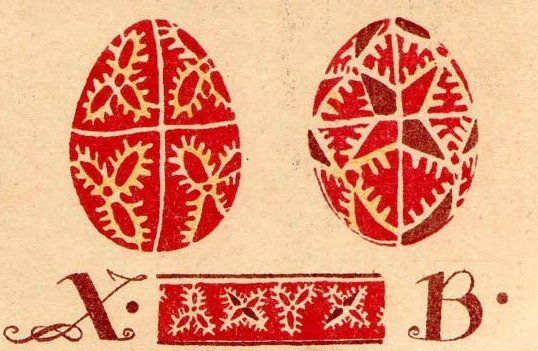Traditions:
Writing Pysanky
Traditions:
Writing Pysanky

Finishing Pysanky
Were pysanky emptied or left full?
Traditional pysanky created for talismanic reasons – as opposed to decorative ones – were made using full, fertilized eggs, and these eggs were never emptied. It was the entire egg, including yolk and white, which was felt to have magical properties. Removing the white and yolk, or even using unfertilized eggs, would have been unthinkable.
The egg contents, when left alone, dried up over time. The water within would evaporate through the shell, and all that would be left wold be a small, hard lump; sometimes it would cling to the eggshell, other times it would break free and roll around inside like a pebble in a rattle.
Even had they wanted to empty the pysanky, it may have been difficult to do so. Although the eggs were not purposely cooked, an inattentive pysankarka might leave them in the oven a bit too long when heating them to remove the wax. In this case, the white might cook slightly, just enough to prevent its removal, at least through a small hole.
Some pysankarky even wrote pysanky on baked eggs – these were called “pecharky.” Baking the eggs preserved the contents and did not affect the dye-ability of the shell, unlike boiling them would. Baked eggs were also lees prone to leaking and spoiling.
Pysanka collectors and conservators in Ukraine, when preserving traditional pysanky, often crack the egg open, physically remove the contents, and then reinforce the shell and glue it back together.
Were pysanky varnished?
No. Varnishing pysanky is a relatively recent innovation (20th century). In earlier times, a pysankarka might rub some pork or duck fat on a pysanka to make it gleam, but would not have thought to varnish it.
Varnishing only became common once pysanky ceased being talismanic objects, and became art objects. Pysanky written for talismanic reasons were re-created annually, so there was no good reason to preserve them from year to year.
How were pysanky displayed?
Pysanky which weren’t used in a ritual manner (hung in stables or bee hives, placed in coffins or near graves, put into newly plowed fields) were usually displayed in the home, often near the icons. Each house would usually have at least one pair of icons in a corner (these would be the wedding icons), and the pysanky would usually be kept either in a bowl near them.
In some parts of Ukraine, pysanky would be turned into birds and hung, suspended from the ceiling, near the icons. A bird’s head would be made of wax or bread dough, and wings and tail feathers of folded paper attached. These “doves” were suspended before icons in commemoration of the birth of Christ, when a dove came down from heaven and soared over the child Jesus.
Back to Traditions home page
Back to MAIN Pysanka home page.
Back to Pysanka Index.
Search my site with Google
